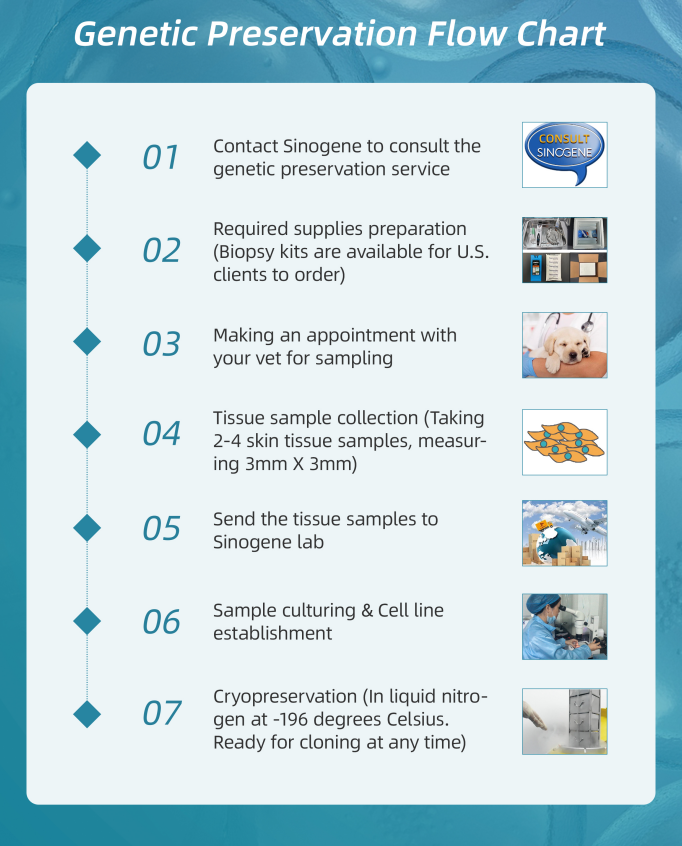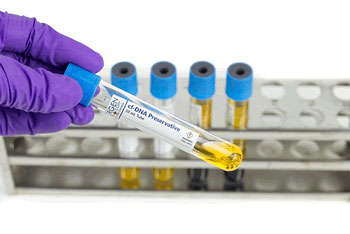
Cell preservation conserves the genes of your cat, dog, horse, or rabbit and is your pet's first necessary step to preserve its genes.
The gene preservation (GP) consists of storing the pet's genetic material so that it can be used later on. The Genetic preservation is typically accomplished by freezing the initial cell, tissue, or germ plasma in liquid nitrogen at a low temperature (-196 degrees Celsius).
At Sinogene, we offer a cutting-edge service known as Pet Genetic Preservation(GP) as it is the first step for cloning. The process assures you that the DNA or genetic material of your pet is preserved in a usable and viable form.
The process of genetic preservation begins with the collection of a tissue sample from your pet. This vital step is the foundation upon which the future possibilities for your pet are built. Once collected, the tissue sample embarks on a transformative journey at the Sinogene cell culture lab. Here, under stringent protocols, the sample is sterilized, processed, and nurtured to facilitate cell growth.
Through our advanced techniques and state-of-the-art facilities, we meticulously count and cryopreserve the cells using Sinogene's proprietary freezing process. The flash-freezing at an ultra-low temperature of -196 degrees Celsius ensures that the genetic material remains viable and ready for future utilization.
With a wealth of experience and expertise in genetic preservation, Sinogene has proudly assisted thousands of pets worldwide in preserving their genetic legacy. Our services have reached clients in nearly 40 countries, instilling trust and reliability in pet owners seeking to secure their companions' genetic future.
Choosing genetic preservation for your pet not only opens the door to cloning possibilities but also offers a timeless legacy for your furry friend. Once your pet's cells are preserved, the cryogenic material remains viable for decades to come. Rest assured that the essence of your pet, encapsulated in its DNA, can be accessed whenever the need arises, ensuring a lasting connection beyond a lifetime.
Join us at Sinogene in embarking on this transformative journey of genetic preservation, where the legacy of your pet transcends time and space, promising a future filled with possibilities.

1. Contact Sinogene to consult the Genetic Preservation service
2. Required supplies preparation ( Biopsy kit is available for US Clients to order)
3. Make an appointment with your vet for sampling
4. Tissue Sample Collection
5. Sent the Tissue Samples to Sinogene Lab
6. Sample Culturing
7. Cryopreservation ( Ready for cloning at any time)
Download Instructions and Suggestions for Sampling Collection, the first step for cell preservation.
Suggestion for Biopsy Skin Tissue Collection from the Body of Your Pet (For Living Pets)
Suggestion for Biopsy Skin Tissue Collection from the Body of Your Pet (For Deceased Pets)
Suggestion for Biopsy Skin Tissue Collection from the Body of Your Pet (Deceased and Frozen Pets)

No. The tissue biopsy process will not harm your dog or cat. We recommend having your veterinarian perform this simple and straightforward procedure during routine procedures such a dental hygiene. Typically, your pet will fully heal from a tissue biopsy in just a few days.
Our pet’s genes can be preserved on a long-term basis through Sinogene’s genetic preservation (GP) service. Our genetic preservation (GP) process is conducted in three steps.
1. We send you a Biopsy Kit or your prepared the required supplies for tissue sampling according to our request, which your veterinarian will use to collect a tissue sample from your cat or dog. Your veterinarian will then send that tissue sample to Sinogene.
2. We culture new cells in our lab from your pet’s tissue sample. This allows us to ensure that the cells are ultimately usable to clone your pet – if you choose to do so.
3. We cryopreserve (freeze) these live cells for growing at a later time if desired.
Yes, you can.
We recommend that you preserve your pet’s gene when your pet is alive which the chance of success for cell culturing can be increased. Because after the pet passes away, the cells start to degrade and the success rate will drop as time passes.
Please contact your veterinarian to obtain biopsy samples (Biopsy Instructions)
Please contact us and ask us about our Genetic Preservation services.
Please do not freeze! It's very important that if your pet passes away, you keep their body and tissue samples cool, but do not freeze them at any stage. This is because freezing, without the correct preparation and media, seriously damages the DNA and can make the samples non-viable.
First of all, DO NOT FREEZE the body. Stay calm and follow the next steps:
Wrap the body in a wet towel and keep it refrigerated.
Contact us as soon as possible (MB: +8617701156079 (WhatsApp), email: jidong.mi@sinogene.org) to learn how to collect biopsy samples.
Send the biopsy samples to the Sinogene cell culture lab.
For the cloning process we need a live viable cell to establish a cell line to be used for the cloning. If the cells have not been cryopreserved following the high technical protocol and has been just preserved in any freezer, then the crystals formed during the freezing process will greatly damage the cells, inhibiting their growth. However, it is different case by case so it is not correct to say that it is always impossible. A special treatment is necessary to establish the cell line and until before we verify the viability of the cells, it is difficult to state if it is possible or not to clone.
It is different in every case. Depending on the condition of the cells the possibility for success can also change. For our cloning process, we need to establish a cell line from the biopsy sample that we obtain from the donor pet. After the pet has passed away, the cells in the body start to degrade itself very fast. If it is possible to obtain a viable cell that can be established into a cell line 7 days after death then it might be possible to clone
At present, cloning can only be achieved from skin tissue samples. To produce a clone, the samples have to be capable of regenerating, and skin tissue is currently the best sample type for this. If you have hair or other samples, you can keep them for if/when later technology becomes available.
No. Pet genetic preservation and cloning are two separate and distinct services. Genetic preservation is the first simple step toward cloning and enables the opportunity for you to clone your dog or cat at a later date – if you choose to do so.
Sinogene takes the security of your pet's genetic materials very seriously. We ensure the safety of your pet's genes in several ways, including duplicate storage of cell lines in multiple locations, alarm systems, and limited personnel access.
We will notify you within four weeks after your tissue sample has been received by us as to whether your dog or cat's genes were successfully preserved.
We will notify you if your dog or cat's tissue sample has not provided a sufficient quantity or quality of viable cells. If this situation arises, you'll be able to send us a second sample for us to culture at no additional cost.
Sinogene stores your dog or cat’s genetic material by using cryopreservation. Cellular material preserved in such a manner has been used successfully decades after the original preservation date.
